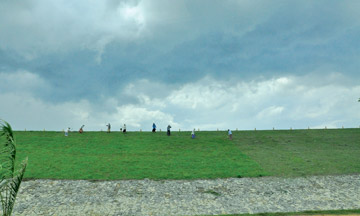Deduru Oya project will be completed by February 2014
By Gamini Warushamana
Sri Lanka has a history of excellence in irrigation engineering and
earth-filled dams was the common technology used in the construction of
large reservoirs and small tanks in the dry zone.
|

The final stretch of the dam under construction. |
|

The rip-rap of the dam |
|

A completed section of the dam |
In the Gal Oya reservoir, the first large scale irrigation project
initiated after Independence, the same technology was used in the
construction of a dam 3,600 feet in length and 140 feet in height.
However, the massive Mahaweli development project which was funded by
foreign donors and located upcountry in steep terrain, used different
technology such as concrete or rock-filled dams.
After the completion of the Mahaweli projects most of the large
engineering projects were handed over to foreign contractors and the
role of the Irrigation Department was limited to maintaining existing
irrigation systems.
In the recent past, the Government relied again on the department and
several mega projects were handed over to the department.
The Rambaken Oya project completed recently is one and the Deduru Oya
project, the largest project where construction work has now entered the
final stage.
The Deduru Oya reservoir project in the Kurunegala district was
planned many years ago but the implementation of the project was a
challenging task because the reservoir bed was inhabited and the whole
project area was covered with privately owned lands.
The social cost of the project is thus high. However, a decision had
to be taken considering the economic viability of the project. An
attractive compensation package was offered to the affected people by
providing them alternative land.
The project will provide huge social benefit to people living in the
dry and intermediate zones of the Kurunegala and Puttalam districts,
which frequently suffer from water scarcity.
The social and economic benefits of the project will offset the
socio-environment cost and the Government in 2006 decided to go ahead
with the project and construction work was launched in May 2007.
The reservoir has a capacity of 75 million cubic metres and will
provide irrigation facilities for 11,115 hectares of paddy land in the
Deduru Oya and Mee Oya basins. Over 15,000 farmer families will receive
direct benefits while about 50,000 families will benefit by domestic
water facilities, lift irrigation and extension of inland fisheries and
other economic activities.
The residential project engineer, Amila Deshapriya said civil
engineering work of the project was almost over.
Civil construction work includes a 2,400-metre long earthen dam, two
sluice structures, concrete spill structure, an approximately 45 km long
left bank main canal, a 33 km long right bank trans basin canal and 27
km long branch canals.
Improvements to minor tanks which will be fed by the two main canals
and development of infrastructure facilities in the resettlement areas
are included.
"The earthen dam is the best option in this project because the dam
is 2.4 km long and concrete or rock-filled options are costly.
We have expertise in this technology and design and construction of
the whole project was done by engineers of the Irrigation Department,"
Deshapriya said.
The Divisional Assistant of the project, Hemantha Senavirathne said
that the 32 km long right bank canal goes up to Inginimitiya reservoir
and the 42 km long left bank canal supplies water to Kolamune Oya.
These areas are in the dry zone and people suffer due to acute
shortage of water. After completion of the project a steady water supply
will be ensured for paddy farming during the Yala and Maha seasons.
Cultivation of other highland crops, provision of drinking water,
flood control, mini hydro power plants and inland fishing are the other
expected economic benefits, he said.
Installation of sluices gates is being delayed as floods are expected
during the monsoon season. However, the entire project will be completed
by February 2014. The mechanical construction is handled by the
Government Factory, Deshapriya said.
The total cost of the project is Rs.6,200 million and Rs.1,800
million has been allocated for land acquisition and resettlement of the
affected people. The project is funded by the Government. |

